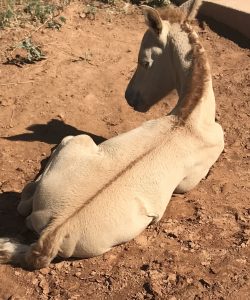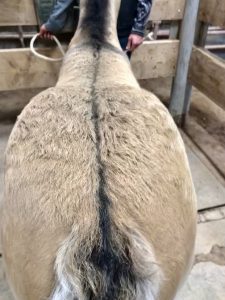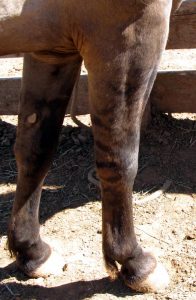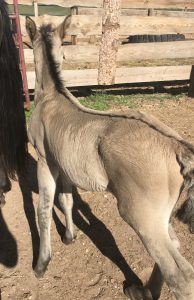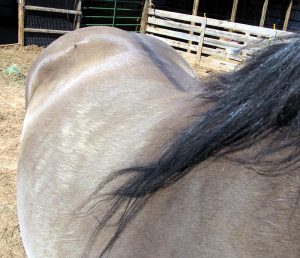 Dun is a dilution gene that lightens both red and black hair on the horse’s body. Dun horses generally have primitive markings. These consist of a dorsal stripe (lineback) and possibly one or more of the following: bars on the sides of the hocks as well as above, below or behind the knees, a stripe over the withers, and sometimes concentric rings on the forehead known as cobwebbing. Bay dun, also known as zebra dun, is the most common expression of the dun factor. These horses have black points and bodies of some shade of tan or yellow. Their heads are usually darker than the body shade. Grullo or grulla results from the effect of dun on a black horse. These horses have black points and generally black or dark heads. Body colors vary from a bluish color, some almost light enough to be silver, through a beige shade. Primitive marks are black. There are also some dun shades with non-black points, referred to as red duns or claybank duns, which are the result of the dun dilution on a chestnut horse. Folk wisdom holds that lineback duns are very tough and durable, and are good horses for extreme situations. They generally have a reputation of being very dependable and standing up well to hard use. For more information on the dun dilution in Morgans, visit the Morgan Colors website.
Dun is a dilution gene that lightens both red and black hair on the horse’s body. Dun horses generally have primitive markings. These consist of a dorsal stripe (lineback) and possibly one or more of the following: bars on the sides of the hocks as well as above, below or behind the knees, a stripe over the withers, and sometimes concentric rings on the forehead known as cobwebbing. Bay dun, also known as zebra dun, is the most common expression of the dun factor. These horses have black points and bodies of some shade of tan or yellow. Their heads are usually darker than the body shade. Grullo or grulla results from the effect of dun on a black horse. These horses have black points and generally black or dark heads. Body colors vary from a bluish color, some almost light enough to be silver, through a beige shade. Primitive marks are black. There are also some dun shades with non-black points, referred to as red duns or claybank duns, which are the result of the dun dilution on a chestnut horse. Folk wisdom holds that lineback duns are very tough and durable, and are good horses for extreme situations. They generally have a reputation of being very dependable and standing up well to hard use. For more information on the dun dilution in Morgans, visit the Morgan Colors website.

